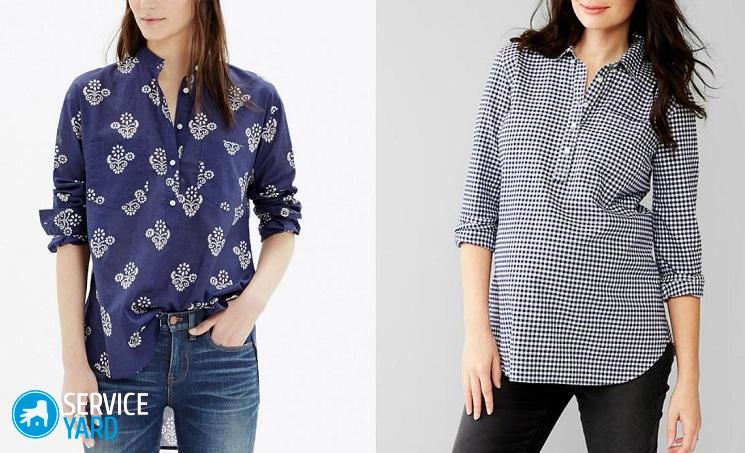Make tucks on the back of the shirt

A fitted shirt emphasizes the dignity of a male figure. Its owner looks particularly slender and broad-shouldered - of course, if he is initially distinguished by a good physique. Classic shirts are often made too loose. This is not always liked by those who do not like to wear jackets. It’s not so difficult to give the product the desired silhouette. It is enough to make tucks on the back of the shirt. We will discuss this now.
to contents ↑Where to go?
Sewing a classic shirt is a rather complicated process. If you carefully consider it, then make sure that the seams are unusual there, and there are no allowances anywhere, and all the details are completely repaired. Try to rip something and download again? It is unlikely that it will turn out as beautiful as a factory product. Therefore, the question arises of how to make tucks on the shirt so that it would not be necessary to cut anything and restore a rather complicated seam.
But there is always a way. It is necessary to make vertical tucks, and the only part that is suitable for this is the back.
Important! If you try to take the men's shirt from the sides, the seams will turn out to be very rough, and the product will instantly lose its signature look.
Some models can remove excess fabric from the shelves, but this is not the best option:
- all seams on the shelves are very clearly visible;
- in the front quite often there are pockets, valves, that is, it will be difficult to make seams neatly.
On the back, vertical seams look very organic, even the most picky observer does not pay attention to them, deciding that this is just such a style.
to contents ↑Sew a shirt
So, you decided that you will suture the back. Ripping apart is not necessary. But it will take the most ordinary things:
- tailor pins;
- crayon or aquamarker;
- ruler or tape;
- sewing machine.
You don’t need to mark anything in advance, everything is done right on who will wear this shirt:
- Turn the shirt inside out.
- Ask your “model” to put it on and fasten it.
- Mark the waist line on the shirt.
- Find its middle and put a point (on the lower back).
- Note where the waist line will intersect with the tucks on the back of the shirt - they are supposed to be two, and they should be located strictly symmetrical.
- Chuck the tucks - do not forget to make sure that they should be placed vertically, and besides, they should be the same in length.
Keep in mind that often men's shirts are made on a yoke. In this case, it will be very reasonable to arrange the tops of the tucks where the yoke is connected to the main details of the back.
to contents ↑Important! Be sure to also see if the loose large pieces of fabric are left below. This is especially true when a man has very narrow hips. In such cases, it is more convenient to bring the tucks on the back of the shirt to the bottom - the shirt will look much more elegant.
Start sewing
When you have outlined, tried on and the appearance of the product completely satisfied you, you can begin to “machine work”. But sewing on pins is very inconvenient, so we do the following:
- We mark with a chalk or aquamarker the top of each tuck.
- We make a mark on the waistline where it intersects with the future tuck.
- Immediately on the waist line we note the width of the tuck.
- For convenience, we connect the width marks and the vertex along the ruler.
- We remove the pins.
Correct
Of course, everything looked perfect on the model, because that was what you were aiming for. It seems that you have precisely drawn all the lines.But all this does not give an absolute guarantee that the tucks on the finished product will be symmetrical and the same. It is better to measure seven times, and only then stitch:
- Define the line of the middle of the back - there you have a point.
- Fold the product in half so that the fold is exactly in the middle of the back.
- Do not forget that you need to carefully combine the side and shoulder seams, as well as the lines of the armholes.
- Insert three pins into the fold line - from below, at the waistline and from above.
- Connect the punctures of a straight line.
- Check the perpendicularity of the middle of the back and waistline (a very convenient thing is a tailor's square).
- Check how dart lines match. If they diverge, they must be adjusted.
Important! There are situations when tucks do not have to be the same. If the man’s spine is noticeably curved, check only the symmetry about the midline, you do not need to align the tops, as well as the depth.
Shutdown
The next stage of work is the grinding of tucks. The order is the same as when sewing any other product with similar details:
- Sweep tucks strictly along the lines.
- Try on a shirt on the model and see how it all will look.
- If necessary, make another correction.
- Stitch the tucks, paying special attention to the peaks - there should not be sharp transitions, the transition to the main fabric should turn out very smooth.
Where is the iron?
The shirt is almost ready, there were real trifles - more precisely, even one. Any tuck must be ironed correctly:
- Put the shirt on the ironing board with the wrong side up.
- Set the knob to the desired fabric.
- Iron the tucks to the midline of the back.
Stock footage
Sewing starts with little things. I liked to adjust the shirt with tucks on the back and everything turned out well? Feel free to stitch something more complex. Having mastered the technology, you can sew absolutely any product, both male and female or children's wardrobe.
- How to choose a vacuum cleaner taking into account the characteristics of the house and coatings?
- What to look for when choosing a water delivery
- How to quickly create comfort at home - tips for housewives
- How to choose the perfect TV - useful tips
- What to look for when choosing blinds
- What should be running shoes?
- What useful things can you buy in a hardware store
- Iphone 11 pro max review
- Than iPhone is better than Android smartphones




